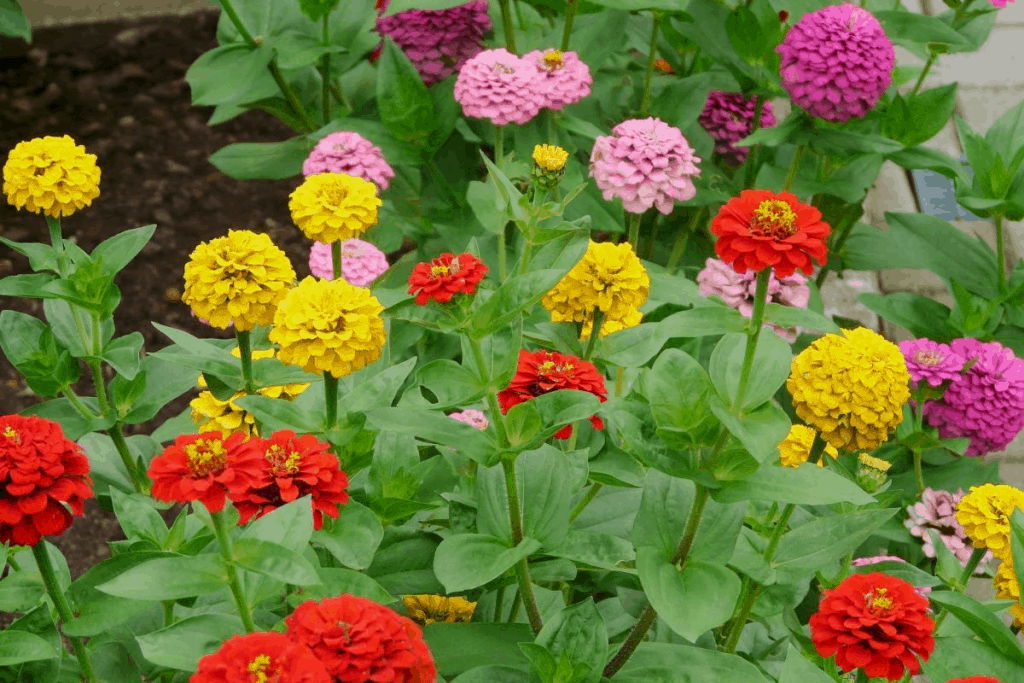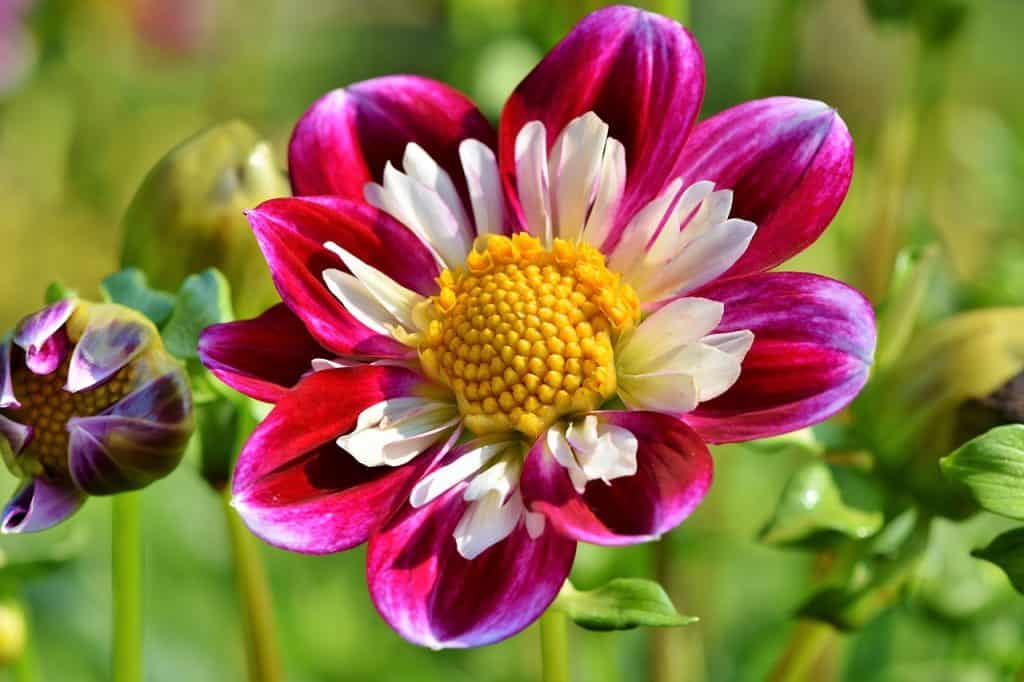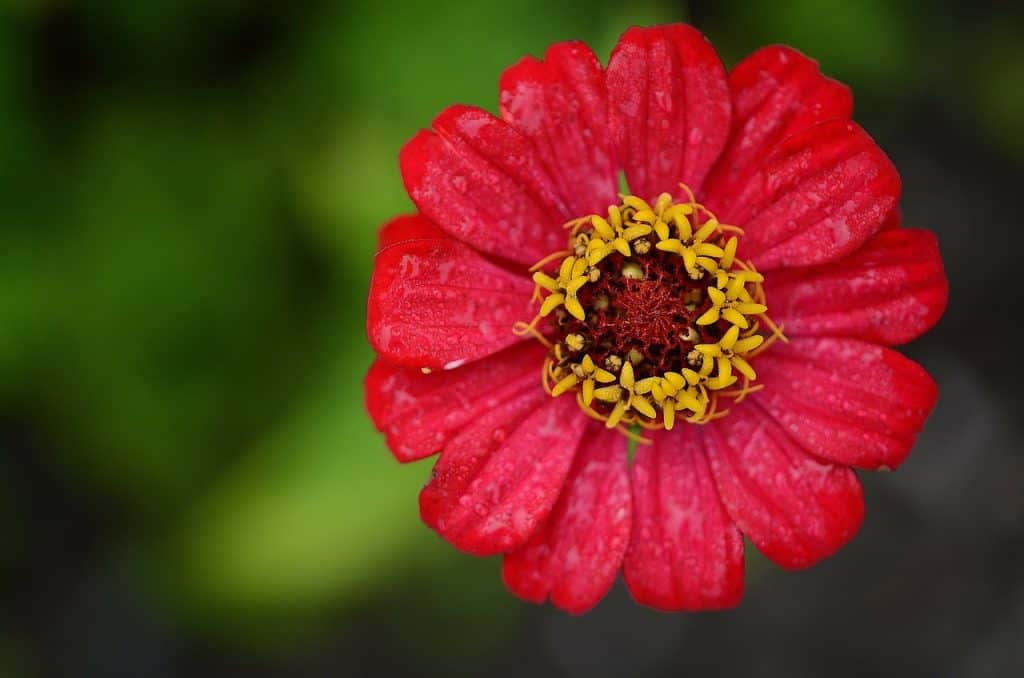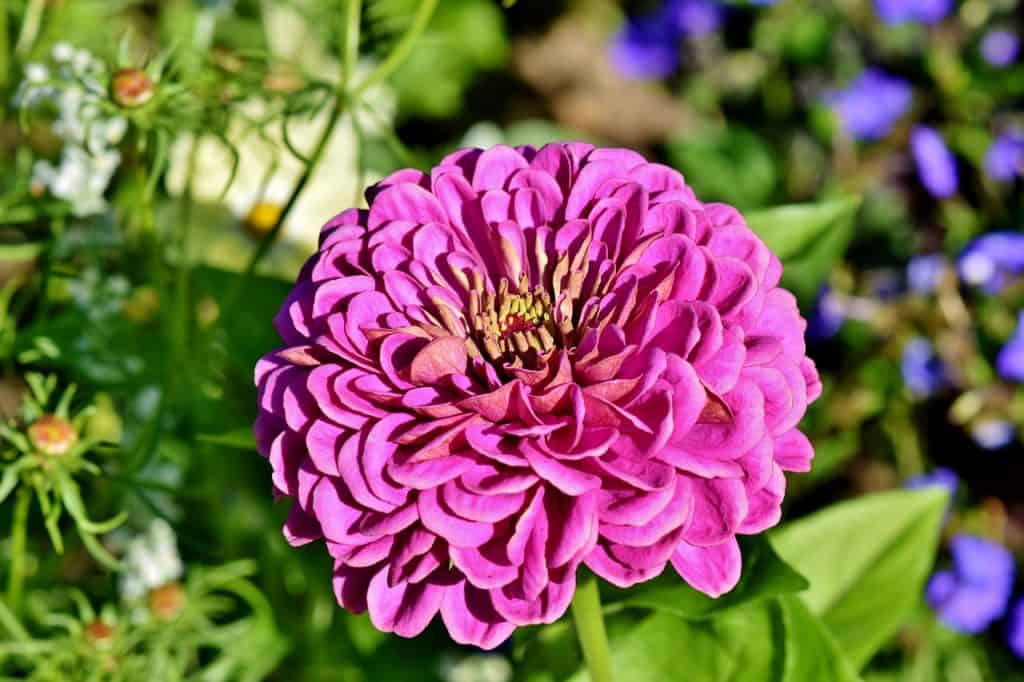Flower Glossary is reader-supported. When you buy through links on our site, we may earn an affiliate commission.
We consider zinnia plants to be one of the easiest and most colorful flowers to grow.
Such cheerful flowers have harnessed so much fame that the National Garden Bureau (NGB) named the zinnia “Flower of the Year” in 2011.
In this article, we’ll give you a step-by-step guide to planting your first zinnia seed. We’ll also provide valuable tips to keep your zinnia garden flourishing under perfect conditions.
Let’s get started!

Table of Contents
Why You Should Grow Zinnia Flowers
There are a lot of attractive options when it comes to planting flowers. Why have zinnias continued to be a popular option throughout the year?
Zinnias Are Efficient and Fast Growers
Since Zinnias are annual plants, they’re much faster to blossom than perennial plants. All you need to do is wait for summer, sow the seeds, and you’ll have pretty flowers in a matter of weeks!
We’ve heard accounts of people not even preparing the soil before seeding. They’d sprinkle zinnia seeds, make sure to water these spots every two days, and the zinnias grow naturally.
Zinnias are efficient because they don’t require a lot of maintenance. They’ll shed out any weeds and will require little fertilizing and barely any mulching.
Lastly, if you want your plant to produce more flowers, you can buy Zahara zinnias. They’re hybrids of Z.elegans and Z.angustifolia that are resistant to powdery mildew, a deadly fungal disease.

Source: Gardening Know How
Zinnias Are Magnificently Colorful
Zinnias come in a variety of bright colors. Not only do they feature almost every palette of bright colors, but they can also combine colors in a single flower. They’re among few multi-colored tribes within the daisy family.
Here are a few examples of cultivars showcasing those preposterous palettes.

Pop Art White and Red
This gorgeous plant produces large, 3-inch across, double-flowered blooms. It features predominantly white petals with a splash of wine-red.
It’s known to blossom profusely in the middle of summer and continue to do so till early fall. It’s also resistant to disease.
Green Envy
Zinnia Green Envy flowers have unorthodox semi-double blooms that grow on long stems. It comes with a lime-green color that makes it attractive to wildlife.
Since they’re more tolerant of the absence of sunlight, they can be grown in containers or gaps. They’re also a top choice for cut flowers.
Persian Carpet/Mexican Zinnia
Also known as narrow-leaved zinnias. This novelty winner sports single and double flowers. They’re bi-colored with gold, burgundy, red, orange, and cream. They were also selected among 1952 All-America Selections’ best picks.
It’s a little on the smaller side and becomes bushier compared to the other types.
Candy Cane
The most festive zinnia flower of all. The blooms are 2-inches across and grow on sturdy stems. They’re a mix of yellow, purple, scarlet, orange, and rose.
This collection of delightful colors will transform your garden into a scene straight out of an oil painting!
Zowie Yellow Flame
Featured on All-America Selection 2006, this variety of zinnia is beloved by millions of gardeners.
The blooms are around 3 inches across, and the plant itself is about 2 feet tall. The buzz about this flower is that it starts with a traditional magenta-pink color, then slowly darkens to a more ruby color as it matures, until it ends with yellow. Incredible.

Zinnias Are Readily Available Every Year
If you want to save some zinnia seeds for next season, all you have to do is leave the flowers to dry on the stem.
When they’re fully dried, take off the seedheads and delicately crush them against the palm of your hand. You’ll be left with the seeds of next season’s crop.
To store the seeds, place them in a dry and cool place, and set a label for it with your seed swap’s date.

Source: Daves Garden
Planting Zinnia Flowers
Zinnias can grow in almost any climate, except frost.
Since they’re susceptible to frost, you should wait until the last day of frost according to your local frost dates. Generally, zinnias can be planted anywhere from Zone 3 to Zone 10, making it suitable for most hardiness zones.
Typically, the minimum temperature to grow zinnias is around 60 degrees Fahrenheit (16 degrees Celsius). However, the optimum temperature for zinnias ranges from 74 to 84 degrees Fahrenheit (23 to 28 degrees Celsius).
It’s recommended that you start sowing the seeds in a periodical manner, and not all at once. In other words, you should sow some seeds once every week for several weeks to extend the flowering phase.
Setting the Environment
An essential thing for a healthy environment is the sun. You should make sure the planting site is outdoors and getting full sun during the daytime to ensure optimum growth.
The second most important thing is good air circulation. The most dangerous things for flowers are fungal infections, namely, powdery mildew, which can ruin an entire season’s crop’s foliage.
Due to their easy to grow nature, almost any soil can grow zinnia flowers. However, if you want the best for your plants, you should make sure your soil is organic and well-drained. Also, make sure the soil pH doesn’t exceed 7.5 or fall below 5.5.
You can also amend your soil with compost, which will help the plants grow even better in your flower beds.
Seeding the Soil
Start by spacing the plants apart. Depending on the variety, you can space them apart anywhere from 4 to 24 inches. Most varieties are placed 6 inches apart and 2 inches between the next row.
Next, sow the seeds not further than ¼ an inch deep.
Seedlings of the zinnia plant should appear in less than a week for most varieties. Blooming could take more time depending on the soil and weather conditions. You should be able to see blooming in no more than 2 months.
We try to diminish any risk of powdery mildew developing. So, when the seedlings surpass three inches in length, we thin them out to maintain maximum air circulation.
You can harvest the zinnia flowers after 60 to 70 days. Some varieties will take more or less time, but you’ll be able to tell for yourself when they’re ready for the flower bouquet!
Planting in Containers
Planting zinnias in containers is a cost-effective way to grow zinnias. All you need to do is get a transplant from the garden or nursery and start them from scratch. Since the seeds are large and grow quickly, it won’t be long until your flowers start germinating.
If you’re planning to put the zinnia containers outside in the summer, you can begin growing the seeds inside for about 6 weeks. Ensure the seeds are covered by ¼ inches of soil until they sprout, then take them out in a sunny spot.
Caring for Zinnia Flowers
All you need to do is maintain some moisture in the soil and fertilize now and then.
Deadheading your zinnias as the flower fades can promote more growth and keep your plant full and bushy. Deadheading is done by trimming off the dead flower at its stem.
Zinnia Container Care
Once the container containing the sprouted seeds is out in the sun, caring for them is a walk in the park. Just make sure the plants are getting enough water every couple of days. Don’t forget to add drainage holes, or the roots will get soggy from the standing water.
Finally, make sure the plant stays dry and provide adequate air circulation to prevent any fungal infections.

Planting and Caring for Indoor Zinnias
Growing Zinnias indoors is also possible, with the right amount of preparation.
Start by filling a container with a high-quality potting mix. Adding sand is a smart way to improve the drainage. You don’t want your zinnias to grow in soggy conditions.
Since outdoor zinnia plants receive a lot of sunlight, even the most well-lit indoor area may not suffice. You’ll most likely need a grow light, or two fluorescent tube fixtures (one warm and one cool)
Top the plant with water every time the soil dries out. Never leave the plants standing in water, and fertilize the flowers every 2 weeks using a water-soluble fertilizer.
Again, the blooms will last for longer if you deadhead the flowers as soon as they start to fade.
Staking Zinnias
It’s true; zinnias don’t usually grow very tall. However, some strains, like Zinnia Angustifolia, can grow to be several feet tall. It’s best for these types of creeping zinnias to be staked to avoid being knocked over or getting wet.
The best strategy to stake your plants is to use one stake for each plant. Make sure the stake will be longer than the zinnia plant when it matures. You can also swap stakes for tomato stakes or wire cages.
It would be best if you started staking tall zinnias a couple of weeks after the seeds have sprouted. It’s important not to sink the stake into the roots when placing them.
Finally, tie the plant to the stakes using twine.
Wrapping Up
If you’ve followed through our guide, you’re now capable of enjoying the blooms of 22 different zinnia varieties. Not only can you enjoy the wide spectrum of colors in your window boxes, but you can also learn more about gardening and incorporate your acquired knowledge into future projects!